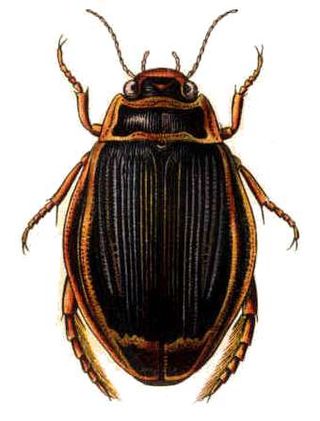
Dytiscus is a Holarctic genus of predaceous diving beetles that usually live in wetlands and ponds. There are 26 species in this genus distributed in Europe, Asia, North Africa and North and Central America. They are predators that can reduce mosquito larvae.

The Mymaridae, commonly known as fairyflies or fairy wasps, are a family of chalcidoid wasps found in temperate, subtropical, and tropical regions throughout the world. The family contains around 100 genera with 1,400 species.

Parasitica is an obsolete, paraphyletic infraorder of Apocrita containing the parasitoid wasps. It includes all Apocrita except for the Aculeata. Parasitica has more members as a group than both the Symphyta and the Aculeata combined.

Cephoidea is a small superfamily within the Symphyta, commonly referred to as stem sawflies, containing some 100 species in 10 genera in the living family, Cephidae, plus another 17 genera in the extinct family Sepulcidae. They first appeared around 212 million years ago in the Norian Age, and are diurnal. Most species occur in the Northern Hemisphere, especially in Eurasia. The larvae are stem borers in various plants, especially grasses, but sometimes other herbaceous plants, shrubs, or trees. A few are pests of cereal grains. They are exceptionally slender for symphytans, often resembling other types of wasps, and they are the only Symphyta which lack cenchri. They are sometimes postulated to be the sister taxon to the Apocrita, though the Orussidae are more commonly considered such.

The Baeomorphidae, are a very small family of rare, relictual parasitic wasps in the superfamily Chalcidoidea, known primarily from fossils. Only two extant species are known, each in its own genus, one from New Zealand and one from Chile, and little is known about their biology, though there is suspicion that they are parasitoids of the relictual true bug family Peloridiidae.

Kikiki is a genus of fairyfly wasps containing a single species, Kikiki huna, known from Hawaii, Costa Rica, Nagarcoil and Trinidad. At 0.15 mm (0.0059 in), it is the smallest flying insect known as of 2019. It is a close relative of wasps in the genus Tinkerbella. It was discovered in the Hawaiian Islands by John T. Huber and John W. Beardsley, and published in 2000. The name Kikiki huna consists of two Hawaiian words that both carry the meaning 'tiny bit'.
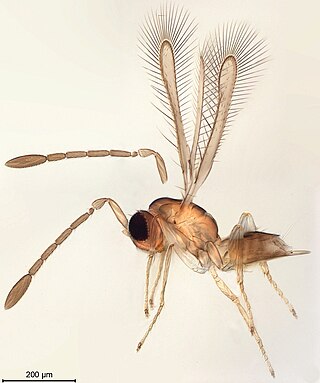
Arescon is a genus of fairyflies. It contains the following species:

Tinkerbella is a genus of fairy wasps, containing the single species Tinkerbella nana from Costa Rica. It is one of the smallest known flying arthropods and belongs to the family Mymaridae.

Gonatocerus triguttatus is a species of fairyfly. It is an egg parasitoid of the glassy-winged sharpshooter, Homalodisca vitripennis. It was originally described from Caroni County, Trinidad.
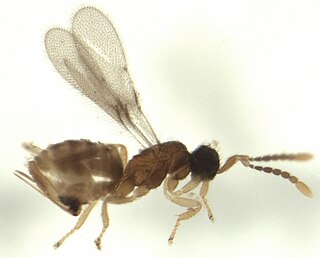
Acmotemnus is a genus of fairyflies in the family Mymaridae. This genus has a single species, Acmotemnus luteiclava, found in New Zealand.
Anagrus incarnatus is a species of fairyfly. It is an egg parasitoid of Cicadella viridis, several genera and species of Delphacidae (Hemiptera), and also Orthotylus virescens. It's native to the Palearctic.
Anagrus armatus is a species of fairyfly. It has been found in Florida and Puerto Rico.

Ophelimus maskelli is a species of chalcid wasp about 1mm long, known as the eucalyptus gall wasp, indigenous to Australia and New Zealand, and invasive in the Mediterranean, the Middle East, North Africa, South Africa, tropical Asia, and the United States (California). It is considered a plant pest as females lay eggs on immature eucalyptus leaves; the larvae produce galls on the leaves. Heavy infestations induce much galling which causes widespread defoliation and loss of growth. Wasps may emerge in large numbers in the spring, forming clouds which are a nuisance to humans.

Dicopomorpha is a wasp genus in the family Mymaridae.
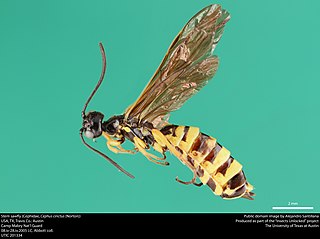
Cephus cinctus, also known as wheat stem sawfly, is a slow flying, yellow and black coloured, destructive pest found mainly in western North America.
Anaphes nitens is a species of fairyfly, a chalcid wasp in the family Mymaridae. Native to Australia, it is an egg parasitoid of the gum tree snout beetle, a pest of Eucalyptus trees, and has been used in biological pest control of that species.

Anagrus is a genus of fairyflies, in the family Mymaridae, comprising over 90 species, a number of which are employed as biocontrol agents. They come in a wide array of colors such as, brown, orange, black and pale. For classificatory purposes, the genus is divided into three subgenera Anagrella, Anagrus and Paranagrus. The adults lay eggs on the host, mainly Hemiptera, with a few using Odonata as hosts.
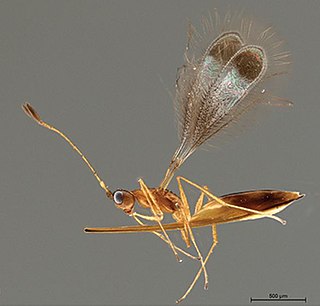
Polynema is a genus of fairyflies or fairy wasps, insects in the family Mymaridae.
Dicopus is a wasp genus in the family Mymaridae. About 15 species have been described in the genus.














